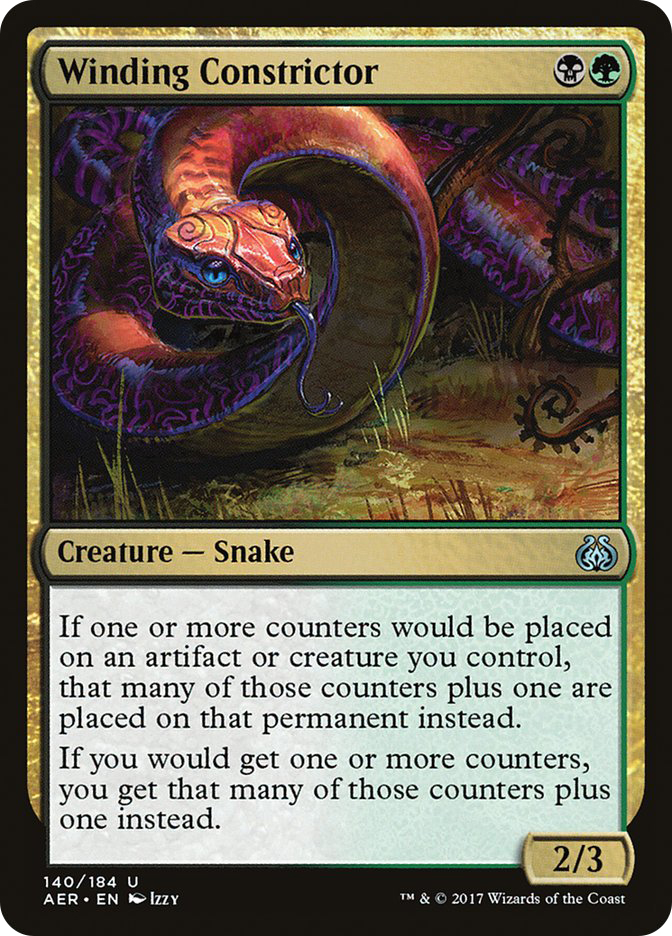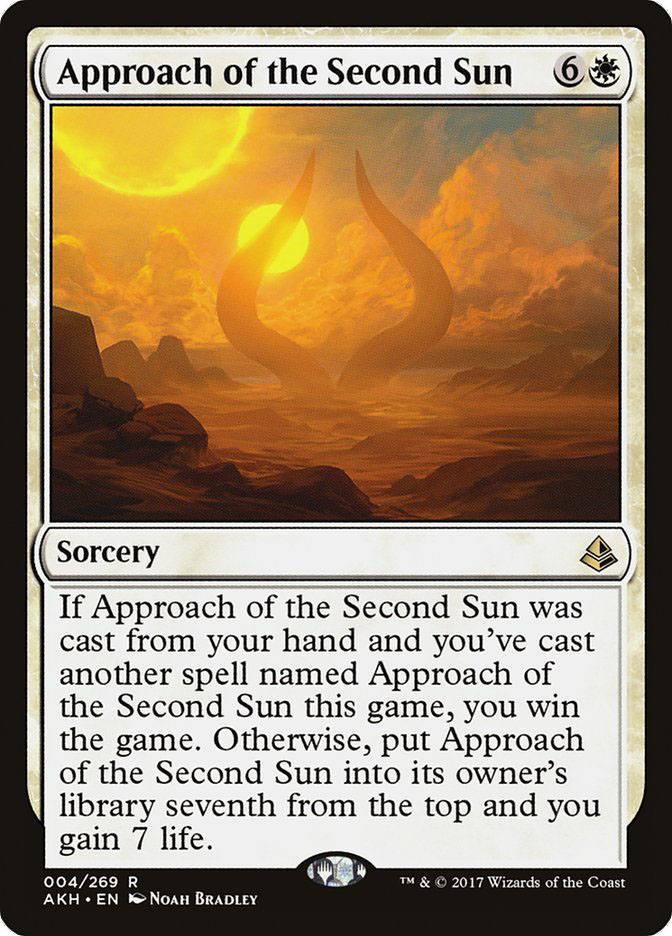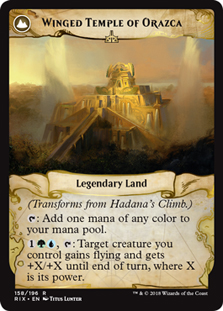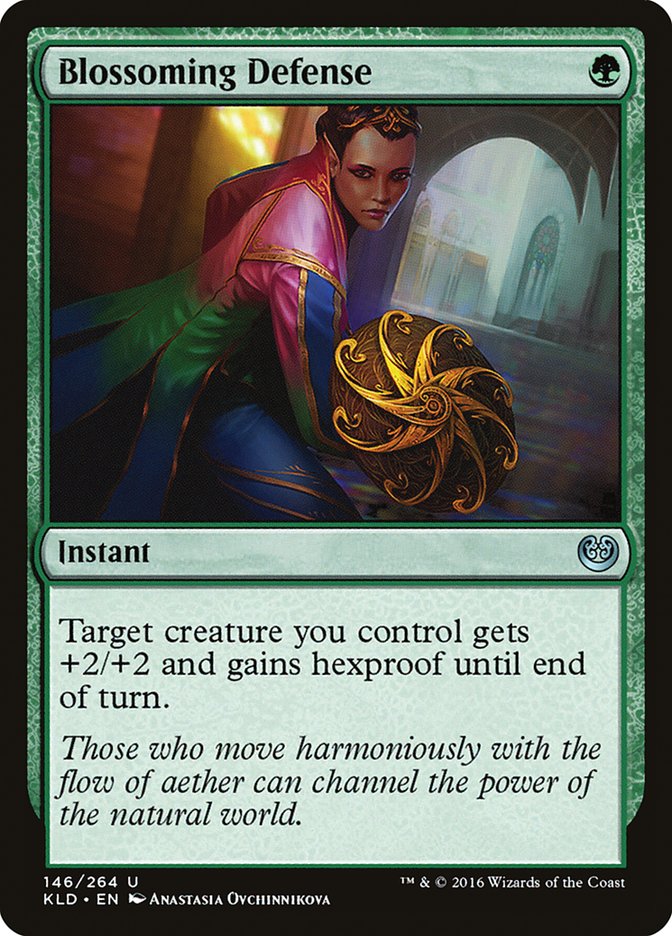Back in the prelude to this Standard season, I was very high on the card Hadana’s Climb. I thought it would be worth splashing for in B/G Constrictor and wrote about its potential role in Winding Constrictor decks here and here. At that time, I was more excited to play Winding Constrictor than I had been at any point since the rotation of Nissa, Voice of Zendikar.
Rivals of Ixalan Standard started in earnest soon after I wrote those articles. I was unable to attend the first Standard tournament of the season, and the results from it did not look promising for my grand Hadana’s Climb ideas. B/G Constrictor showed up in force at #SCGDFW, but none of those pilots chose to give Hadana’s Climb a try.
The very next weekend at #SCGPHILLY, I had a chance to play a Climb variant of Constrictor myself to prove my ideas. Instead, I chose to play a boring stock B/G Constrictor list. As much as I would have loved to see how my ideas held up in a competitive setting, life had stopped me from getting as much testing in as I would have needed to feel comfortable subjecting my teammates to a brew.
In the end, though, my desire to not subject my teammates to undue risks backfired hard. The stock B/G Constrictor list I played felt so miserable in my hands that I had to write an entire article about the problems with it. For the first time in a long time, I was ready to swear off casting Winding Constrictor for good. You know, after I played a Hadana’s Climb variant through a competitive league on Magic Online to make sure that didn’t solve all my problems. Here’s the list I decided to play with for my last Constrictor hurrah.
Creatures (27)
- 4 Verdurous Gearhulk
- 2 Bristling Hydra
- 3 Servant of the Conduit
- 4 Winding Constrictor
- 2 Rishkar, Peema Renegade
- 4 Glint-Sleeve Siphoner
- 4 Walking Ballista
- 4 Jadelight Ranger
Lands (24)
Spells (9)
Sideboard

Obviously I went 5-0 in that League. And then 4-1 in each of the next three I played to make sure that 5-0 wasn’t just some fluke occurrence. Hadana’s Climb was excellent, and the deck felt fundamentally different and better than the stock B/G list I had played previously.
Turns out Snakes are the ones who decide when they’re done with their prey, not the other way around.
Motivation for the Climb
So this is the part of the article where I try to sell you on the virtues of playing Hadana’s Climb in your B/G Constrictor deck. And it should be a hard sell, as you should be wary of anyone telling you to add a color to a deck. Honestly, advocating for more colors in a Magic deck makes me feel like a shady salesperson, trying to drive hype on a showy but inferior product. That’s not the case right now, but it is so often that I can’t shake the association.
There are a lot of similarities, actually. On one level, it’s easy to extoll the virtues of adding another color. New colors are flashy and exciting. They provide all sorts of cool features and tricks to talk about ad nauseum. Whenever the mark makes noise like they want to talk about something of substance, perhaps the cost of a third color to your consistency, you always have more superficialities to bring the conversation back to.
The thing to look out for in these conversations is if all the arguments in favor of splashing another color are just some variant on reading card text to you. If you ask me why I want to play Hadana’s Climb in my Constrictor deck, and all I can reply with is how Hadana’s Climb lets you put counters on your creatures and then double their power once flipped, all I’m doing is reading the card text to you. If I start explaining the synergies with Winding Constrictor, Walking Ballista, and Verdurous Gearhulk, all I’m doing is reading multiple card texts to you. This stuff is important, but knowledge of it should be a given going into the conversation. What you should be looking for from me or other people trying to get you to play a third color is acknowledgment of the trade-offs involved and a clear explanation of why the card text is particularly worthwhile in the context of the format at large.
Let’s dive right in. Why is Hadana’s Climb worth splashing an entire third color for right now?
First, let’s take a step back and take a broad look at the format. One the far aggro end, you have Hazoret the Fervent decks featuring Bomat Courier. There are a few flavors here, but they all do similar things and have the same weaknesses. These decks are a reason to want to play a Winding Constrictor strategy. They are weak to Walking Ballista and don’t at all like playing against a low-to-the-ground deck with creatures that are all very slightly bigger than theirs. You even have access to Vraska’s Contempt to deal with pesky Hazorets. Note that I haven’t mentioned Hadana’s Climb once here; in fact, I sideboard out all copies of Climb in this matchup. If the metagame were all Hazoret decks, I would play pure B/G Constrictor.
On the other end of spectrum from the Hazoret decks, you have the Torrential Gearhulk decks. These days, the Torrential Gearhulk decks are basically all The Scarab God decks. These decks are the enemies of midrange strategies like ours. Most of them look a lot like this Classic-winning deck from Todd Stevens:
Creatures (6)
Lands (26)
Spells (28)

Take a look at that list. Yeah, it’s not pretty. At least, not for us Snake aficionados. It’s chock-full of removal and powerful, game-warping late-game threats and kind of reads as a laundry list of things we don’t want to play against.
Here’s where we start getting into why Hadana’s Climb is so good. Blue and black are historically colors that don’t answer enchantments very well. Once Hadana’s Climb hits the battlefield, it’s there to stay. And on the battlefield, Hadana’s Climb is a very scary thing for our control opponent to have to stare down. Any of our creatures can become lethal or near-lethal threats at a moment’s notice if the opponent leaves their shields down for a single turn.
And that’s really what we have to play for in these matchups: an opening. We play the whole game to create one opportunity to press in for damage. Normally, you can manage that much. Commit enough to the battlefield to make them use all of their mana stabilizing and you get one chance to punch through with the last of your resources. With Hadana’s Climb, the last of your resources is often enough to actually win the game, when without it your efforts are generally in vain.
The transition of control decks away from Approach of the Second Sun strategies is good for us, as it means the control decks are relying exclusively on spot removal and don’t have access to Fumigate or Settle the Wreckage. This means that Bristling Hydra is exceptionally good against them, and the synergy between Hadana’s Climb and Hydra ends up stealing games in this matchup that you would otherwise never win. I’ve forced many Torrential Gearhulk-wielding opponents to cast Disallow targeting a Hadana’s Climb trigger, and they’ve never gone on to win the game from that spot.
The rest of the format is comprised of various midrange flavors, from aggressive midrange decks like Brennan DeCandio’s G/R Aggro deck to controlling midrange decks like the B/W Tokens deck that took second at the #SCGINDY Standard Classic, with some true midrange in the form of decks like Grixis Energy sprinkled in between. Some people would argue that some of these decks aren’t midrange decks, that Brennan’s deck is an aggro deck or that the Tokens deck is a control deck, and those arguments have merit.
For our purposes right now, though, they are midrange decks because they are incapable of going either above or below our Sultai Constrictor deck. They can’t go under us because Constrictor decks are naturally low to the ground due to playing a high density of two-drops and having access to Fatal Push. They can’t go over us because of Hadana’s Climb.
In some sense, I mean that literally: because of the activated ability on Winged Temple of Orazca, the skies do not exclusively belong to our Glorybringer and Rekindling Phoenix-wielding opponents. But more to the point, I mean that Hadana’s Climb lets us do more powerful things in the late-game than our opponents are doing, no matter what their plan for the late-game is, even against the Tokens deck, the whole goal of which is to have a more powerful late-game than the opposition. Take a look at this Magic Online screenshot:
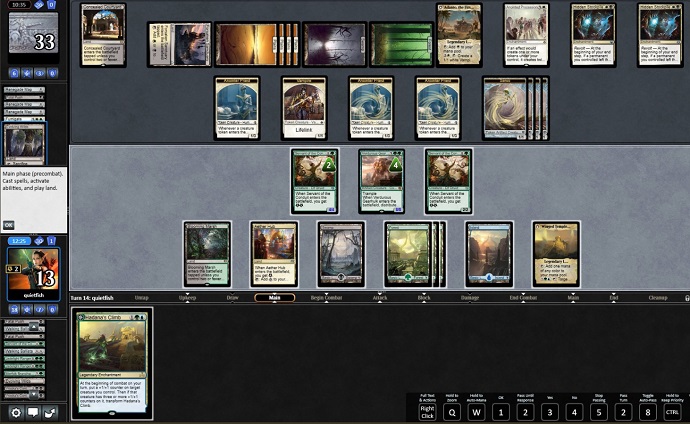
I’m deep into a game with my Abzan Tokens opponent here, and their engine is online. They have two Stockpiles, three copies of Anointer Priest, and an Anointed Procession. They don’t really have access to a more dominant setup. It took a little while to come together, so they only have 33 life right now. Of course, that’s about to change.
The picture is in my first main phase. For those who don’t want to math it out, that Hadana’s Climb in my hand represents 34 points of flying damage this turn. I win this game before they get to untap by activating the Winged Temple I have on the battlefield, casting this Hadana’s Climb, transforming it, and then activating the new Winged Temple. What a steal.
Of course, that picture was of a pretty absurd game, but that kind of thing happens all the time. Before playing the deck, I would have guessed that cool Winged Temple wins would account for probably 20% or so of the deck’s wins. In reality, it’s close to half of the game wins I have with this deck, maybe more than half, and I have a lot of game wins with it. The game-ending power of Hadana’s Climb cannot be overstated.
To summarize these arguments: the existence of Mono-Red in the format makes you want to play Winding Constrictor, but not Hadana’s Climb. Playing Hadana’s Climb gives you game against Torrential Gearhulks by giving you a hard to interact with permanent that lets you capitalize on a moment of weakness in a meaningful way. Against other midrange decks, Hadana’s Climb gives you the edge going long. All in all, Hadana’s Climb makes the Constrictor deck you want to play against the aggressive decks playable against the control decks and great against the midrange decks.
Challenges and Two Branching Paths
I had #SCGINDY to play last weekend, but still found time over the last two weeks to iterate on and improve on Sultai Constrictor in preparation for Grand Prix Memphis this weekend. Here’s the last build I played with:
Creatures (28)
- 3 Verdurous Gearhulk
- 4 Bristling Hydra
- 4 Servant of the Conduit
- 4 Winding Constrictor
- 2 Rishkar, Peema Renegade
- 3 Glint-Sleeve Siphoner
- 4 Walking Ballista
- 4 Jadelight Ranger
Lands (24)
Spells (8)

It’s probably not a surprise that the biggest challenge I faced in tuning a three-color variant of a stock deck was in figuring out how to make the mana work. I tried a few different things, from maxed Fetid Pools to maxed Evolving Wilds. I eventually realized that Evolving Wilds can’t work, as it makes going from double green for Jadelight Ranger to double black for Vraska’s Contempt too difficult. But without Evolving Wilds, the blue was a huge drain on the manabase that necessitated too many taplands. Something had to give.
The two biggest contenders for something that could give were the Vraska’s Contempts and the sideboard blue cards. Without Vraska’s Contempt we wouldn’t need access to double black mana and the manabase would be less demanding, and without blue cards in the sideboard, we could substantially lower our blue source count.
After many matches, I came to the conclusion that Vraska’s Contempt was a more important card against the control decks than Negate, solely because being able to remove their first copy of The Scarab God is so important. In fact, I don’t recommend playing less than four copies of Vraska’s Contempt in the 75, just so you can sideboard up to four against The Scarab God decks. Sideboard games against control often end up with you forcing them to jam The Scarab God early, and you lose on the spot if you don’t have a Contempt ready for it.
The Negates weren’t a huge loss, either, as their importance dropped dramatically with Fumigate and Settle the Wreckage control decks getting pushed out of the metagame. The only other blue card I would consider in the sideboard is Hostage Taker, and the light blue version of the manabase I settled on can probably support Hostage Taker if that’s a desirable route to take.
The header for this section talks about two branching paths, and you might think at this point that the other path is a heavier blue build of the deck. Well, you’d be wrong. I’m actually fairly convinced that the lightest possible blue splash is the correct direction for the deck. No, the other path for the deck is the other way to solve what I like to call the “worst spells” problem of the deck. This happens a lot in Standard, where a deck has 50-ish cards it definitely wants to play, and then the last ten or so are considerably worse. Here’s what I consider the core, best spells of Sultai Constrictor…
Creatures (23)
- 3 Verdurous Gearhulk
- 4 Bristling Hydra
- 4 Servant of the Conduit
- 4 Winding Constrictor
- 4 Walking Ballista
- 4 Jadelight Ranger
Lands (24)
Spells (7)

…and six worse cards. Right now, I have the rest of these slots filled out with:
At various points I’ve tried out Merfolk Branchwalker, Longtusk Cub, Aethersphere Harvester, the rest of the Fatal Pushes, and the last Vraska’s Contempt. The exact removal suite will end up being a metagame call for sure, and the copies of Fatal Push and Vraska’s Contempt I have listed in the core aren’t off-limits. But the last two-drop is very up for debate. Right now I like Glint-Sleeve Siphoner the most, but I still don’t think that Siphoner is very impressive here.
I’ve been a little remiss in my testing in that I haven’t tried a Blossoming Defense build out yet. I’ve historically hated the card in Constrictor decks, and I think that bias has steered me poorly here, as the more I think about Blossoming Defense, the more I like it. It plays super-well with Hadana’s Climb, beats up on Glorybringer, trades super-well against the Vraska’s Contempts everyone’s playing, and is also very likely your best spell against the red decks, protecting your Winding Constrictor from a Lightning Strike. Here’s the build I was going to play at the #SCGINDY Standard Classic had I not made Day 2 of the Open:
Creatures (25)
- 3 Verdurous Gearhulk
- 4 Bristling Hydra
- 4 Servant of the Conduit
- 4 Winding Constrictor
- 2 Rishkar, Peema Renegade
- 4 Walking Ballista
- 4 Jadelight Ranger
Lands (24)
Spells (11)

So there you have it: a build with Blossoming Defense, and a build without it. I’m leaning towards the Blossoming Defense build more myself right now, but haven’t had a chance to get the reps in with it yet.
You can bet that’ll change before Grand Prix Memphis.



